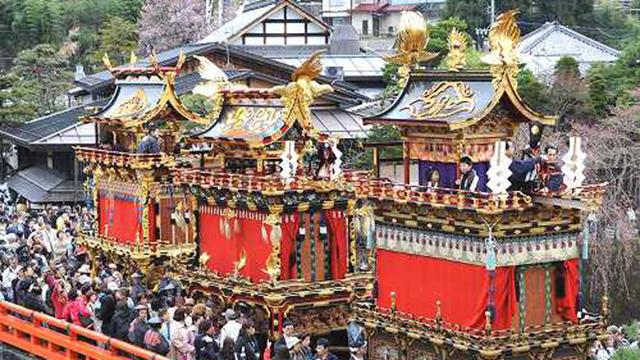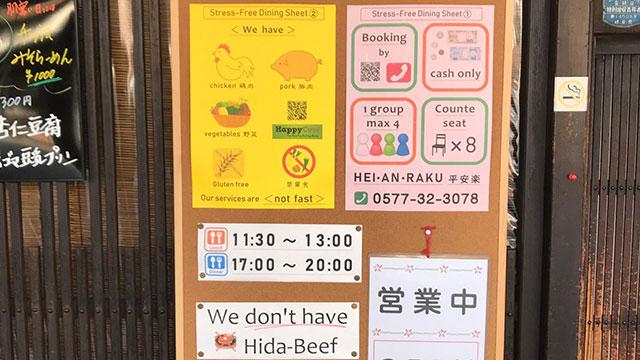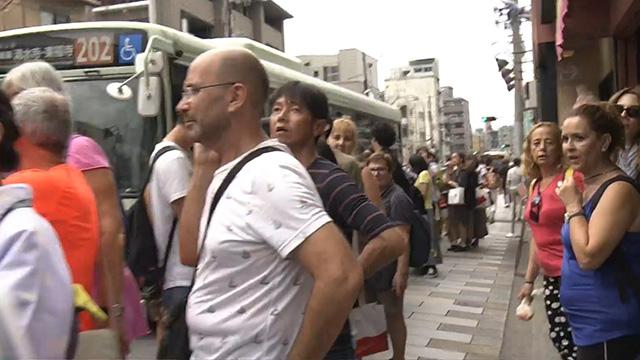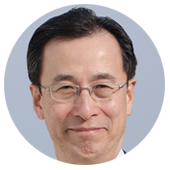Rising number of tourists from overseas
It takes more than four hours from Tokyo by Shinkansen bullet train and then a local train to reach Takayama City in Gifu Prefecture. The city nestles in a mountainous area of the Japan Alps and is known for a spectacular festival that is held each year in spring and autumn. The festival is highlighted by parades of remarkable floats and portable shrines.

Takayama is home to a Chinese restaurant that is ranked as one of the most popular food establishments among foreigners visiting the city, according to the Trip Advisor travel website.
The restaurant, "Heianraku," is run by Hiroshi Furuta and his wife Naoko. I went to find out why a restaurant up in the mountains of Japan serving Chinese food is so popular.


Heianraku has only 12 seats. As I stepped in, I saw several foreigners enjoying their meals. One was a British student studying in Japan and the others were tourists from Australia. I learned this because Naoko kindly introduced them.
Naoko says she wants the restaurant to be stress-free for overseas tourists. All dishes on the menu, such as ramen, fried rice and stir-fried vegetables, are written in Japanese and English. It also offers special dishes for vegetarians, vegans and Buddhists, and has gluten-free food.
Naoko says communication is the most important element of human relations. She treats all guests the same, spending equal time chatting about the weather and asking diners what suits their taste, and so on.
The restaurant only takes cash, not credit cards, because it wants to keep meal prices as low as possible. Naoko uses this as an opportunity to explain the famous Japanese figures printed on banknotes. She also teaches visitors to count money in Japanese.

All of these additional touches help communications
Heianraku was established by the father of Hiroshi Furuta more than 50 years ago, making it one of the oldest Chinese restaurants in Takayama.
Hiroshi and Naoko were not always fluent in English. They put up an English sign reading "Chinese restaurant" at the entrance to their establishment because overseas visitors kept mistaking it for a sushi or soba noodle restaurant. While they initially thought the sign would reduce the number of overseas guests, it had the opposite effect. More foreigners started to arrive because they thought English was spoken at Heianraku.
This changed the couple's way of thinking. They decided to fulfill requests by foreign guests, rather than turn them down.
Today, Heianraku's walls are filled with a countless number of thank you cards that foreign guests sent, as well as foreign currency banknotes given as tips.
Tourism changes local communities
Takayama's municipal office has been working to attract more foreign tourists.
It sent officials to the United States, France, and China to study what visitors to Japan want. It published a detailed guidebook introducing restaurants as well as places of worship for Muslims. In a local shopping street, it set up a counter where foreign tourists can get consumption tax refunds after shopping there -- the first of its kind.
What's more, Takayama is working together with other areas of the prefecture to memorialize Chiune Sugihara who was born in Gifu. Sugihara was a Japanese diplomat in Lithuania in World War II who issued visas to help Jewish people escape Nazi persecution. As a result, the number of visitors from Israel to Gifu has increased.
The population of Takayama City peaked in 2005 at 97,000. It is now 89,000. But the number of foreigners who stayed at Takayama's hotels increased more than 20-fold to 540,000 during the 30 years of the Heisei era. The spillover effect that tourism brings to the city is worth nearly 200 billion yen, or US$1.8 billion, a year.

The increase in foreign visitors is a trend observed not only in Takayama, but throughout the country. It's one of the most dramatic changes in Japanese society during the Heisei era.
Visitors from overseas exceeded the 30 million mark for the first time in 2018, a 10-fold surge from the start of the Heisei era.
Japan's government expects 40 million visitors in 2020 when Tokyo hosts the Olympic and Paralympic Games. By 2030, it targets 60 million.
The increase in visitors brings various benefits to the economy, such as a boost in sales at department stores and revenue to regional communities that face serious depopulation.
Today, all regions of Japan, from Hokkaido in the north through Kyushu and Okinawa in the south, are competing to attract more foreign visitors.
Working with foreigners
Another major shift is a surge in the number of foreign workers. The figure rose about five-fold to 1.27 million during the Heisei era. Most convenience stores in Tokyo are manned by staff from foreign countries like China, South Korea and Myanmar. More farms and construction companies are relying on non-Japanese workers amid a severe labor shortage.

A construction firm pays more than US$3,400 a month to foreign technical interns. That's about the same as what their Japanese colleagues make. The company is now considering offering the interns paid holidays and paid trips home.
The company's manager says it'll be difficult for them to hire people if they don't treat their employees well because such information spreads easily by word of mouth.
In April, the revised Immigration Control Law came into force. It expands employment visa categories to unskilled workers. The change is seen as key to Japan's future economic growth as the country's population keeps shrinking.
However, the Japanese must make an effort to help the foreigners adjust. In one case that made headlines in March, a Vietnamese man working as a technical intern was charged by police for allegedly catching ducks in a Tokyo park. The police say the man simply wanted a change from Japanese food and had decided to catch ducks to make a Vietnamese dish.
Unfortunately, he ran afoul of Japan's wild animal protection law that bans duck hunting without a license.
The case serves as an example of how unexpected problems will occur for foreign workers adjusting to life in Japan. Overcoming problems involving foreign workers will be a major challenge for Japan.
Coexisting with other cultures
Another major event in the early part of the Heisei era was the collapse of the bubble economy and the severe setback to Japan's economy in the 1990s. Since then, Japan has deregulated various fields such as its financial and aviation industries just like the US. In the face of the financial crisis, Japan was forced to get rid of large amounts of bad loans through foreign investment funds in the early 2000s. Japan had to learn to coexist with other economies throughout the 30 years of the Heisei era as part of rapid economic globalization.

As the Heisei era comes to a close, the country is at a turning point. Each Japanese citizen must learn to accept foreign cultures and coexist with them.
In turn, the large inflow of foreigners provides a good opportunity for those people to become familiar with the Japanese. This will not just benefit Japan's economy, but also transmit widespread awareness of the country's culture and values and lead to the formation of friendships across the globe.
I'd like to recommend visitors from abroad to visit not only Tokyo, but also rural Japan to meet and communicate with locals using basic Japanese.
Japanese-style inns and restaurants in smaller cities are the best place to experience the incredible hospitality for which Japan is famous. In addition, working with Japanese coworkers will allow foreigners to understand "ikigai," or the Japanese purpose or reason for living.
Today, national particularism is on the rise worldwide. This makes it all the more important for people around the world to know each other and understand each other's values. I believe this will help prevent confrontations and promote cooperative relationships.
Mr. and Mrs. Furuta, the couple who run the Chinese restaurant, say that they might have had to close the business if it hadn't been for the foreign visitors. They say, "When foreign tourists go home, they recommend things and places they liked to their families and friends. And these people become our next customers. It's like having our own public relations people abroad." Welcome to Japan!
NHK World-Japan offers information about Japanese food, nature, history and culture in 17 languages. It also has programs and websites for learning basic Japanese. I hope NHK World-Japan can serve to deepen understanding of Japan.

